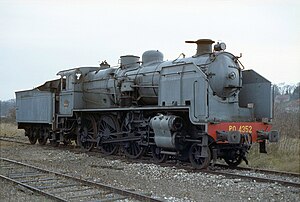PO 4200
| PO 4200, PO-Midi 230 SNCF 230 G |
|
|---|---|
|
PO 4352 in Gray , 1981
|
|
| Numbering: | see text |
| Number: | 170 |
| Manufacturer: | Société de construction des Batignolles , Société alsacienne de constructions mécaniques (SACM), North British Locomotive Company |
| Year of construction (s): | 1914-1923 |
| Retirement: | 1970 |
| Type : | 2'C h2 |
| Gauge : | 1435 mm ( standard gauge ) |
| Length over buffers: | 17,733 mm |
| Service mass: | 107.75 t |
| Top speed: | 100 km / h |
| Indexed performance : | 1400 hp |
| Coupling wheel diameter: | 1750 mm |
| Impeller diameter front: | 820 mm |
| LP cylinder diameter: | 500 mm |
| Piston stroke: | 650 mm |
| Water supply: | 17 m³ |
| Fuel supply: | 4.25 tons of coal |
The locomotives of the series 4200 of the French railway company Compagnie du chemin de fer de Paris à Orléans ( PO ) are Tender - steam locomotives with the wheel arrangement 2 'C. The 170 machines delivered had the company numbers 4201 to 4370. After the merger of the PO with the Compagnie des chemins de fer du Midi (Midi) to become the Compagnie du chemin de fer de Paris à Orléans et du Midi (PO-Midi) in 1933 redrawn them in 230-201 to 230-370 (with gaps). When they were incorporated into the SNCF state railway in 1938, the locomotives were classified in the 230 G series and were given numbers between 230 G 201 and 370.
History and description
The procurement period extended from 1914 to 1923. The locomotives were mainly built by the Société de construction des Batignolles and the Société alsacienne de constructions mécaniques (SACM). Due to the war , the locomotives 4221 to 4270 were built by the North British Locomotive Company in the Scottish city of Glasgow .
These are two-cylinder superheated steam locomotives whose boiler was identical to that of the PO series 3200 and 5300. The cylinders also matched those of the 3200, the chimney with the 5300. The front wheel sets were designed as Bissel bogies . The locomotives were coupled to a relatively short tender and had - typical for PO locomotives - quite small smoke deflectors , which were retrofitted from 1929 after André Chapelon's attempts . In 1947/48, fourteen machines were converted to oil firing to reduce the risk of fire in the pine forests of the Landes de Gascogne .
The locomotives proved to be reliable and robust, they pulled express, regional and freight trains. Gradients of 2.5 ‰ were mastered with a trailer load of 415 t at 80 km / h, ramps of 10 ‰ with a load of 390 t at 50 km / h. However, the machines tended to skid on ramps of more than 25 ‰ . Operational areas were mainly the west and south-west of France, between 1955 and 1966 25 of the machines were relocated to the north.
In 1924/25 the PO 21 sold these locomotives to the Compagnie des chemins de fer du Maroc . 41 locomotives went to Chemins de fer de l'État (ETAT) in 1934 , which they classified as 230-401 to 230 441 in their inventory. Under the direction of the SNCF, the locomotives taken over from the PO were given the road numbers 230 G 201 to 264 and 312 to 370, and the machines sold to ETAT in 1934 became the 230 K 401 to 441.
Whereabouts
The last former PO 4200 were shut down in 1970. The locomotives 230 G 352 and 353 (both built by the Société de construction des Batignolles) were preserved. The 230 G 353 (ex PO 4353) was best known for its use in the 1974 film adaptation of Agatha Christie's crime novel Mord im Orient-Express .
230 G 353 ago from former ETAT - Doppelstockwagen formed special train at Achères , 1982
230 G 353 in the Belleville-Villette station of the Petite Ceinture , 1985
230-G-353 in Ponthierry , 1985
230 G 353 in Les Ormes-sur-Voulzie , 1985
Engine of a 230 G
Remarks
- ↑ due to sales to Morocco
Web links
- PO vapeur 230-G-352 - CFTV (French)
- PO vapeur 230-G-353 - "Orient-Express" SNCF (French)
literature
- Thomas Estler: Locomotives of the French state railway SNCF . 1st edition. Transpress, Stuttgart 2014, ISBN 978-3-613-71480-9 , pp. 20 .
Individual evidence
- ↑ a b Thomas Estler: Locomotives of the French state railway SNCF , p. 20.
- ↑ Philippe Bruyelle: The "Come back" de la Star trainvapeur.fr, March 10, 2014 (French)






